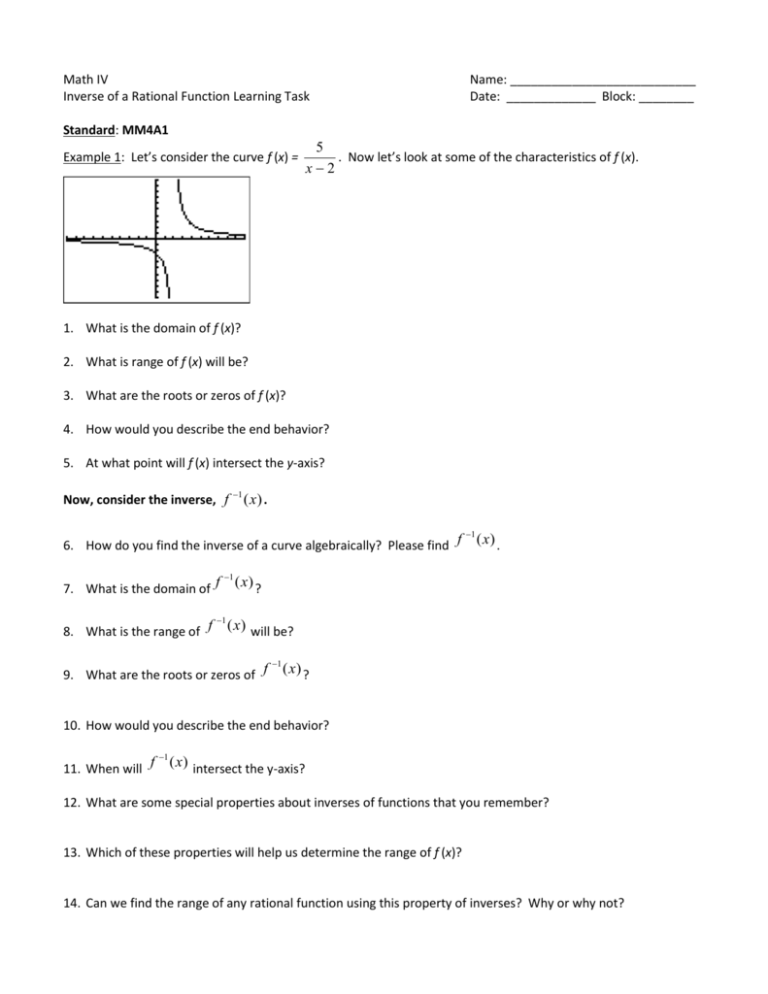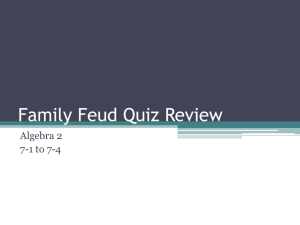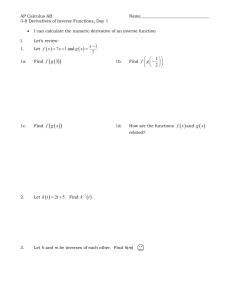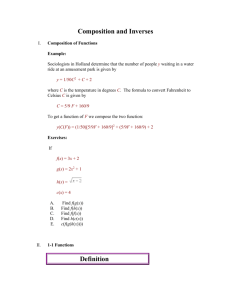
Math IV
Inverse of a Rational Function Learning Task
Name: ___________________________
Date: _____________ Block: ________
Standard: MM4A1
Example 1: Let’s consider the curve f (x) =
5
. Now let’s look at some of the characteristics of f (x).
x2
1. What is the domain of f (x)?
2. What is range of f (x) will be?
3. What are the roots or zeros of f (x)?
4. How would you describe the end behavior?
5. At what point will f (x) intersect the y-axis?
Now, consider the inverse, f
1
( x) .
6. How do you find the inverse of a curve algebraically? Please find f
7. What is the domain of f
8. What is the range of f
1
1
1
( x) .
( x) ?
( x) will be?
9. What are the roots or zeros of f
1
( x) ?
10. How would you describe the end behavior?
11. When will f
1
( x) intersect the y-axis?
12. What are some special properties about inverses of functions that you remember?
13. Which of these properties will help us determine the range of f (x)?
14. Can we find the range of any rational function using this property of inverses? Why or why not?
Example 2:
Let r ( x)
4x 1
. Find all the important characteristics of r(x) and r-1(x).
4 x
For r-1(x):
For r(x):
Domain:
Domain:
Range:
Range:
Roots:
Roots:
End Behavior:
End Behavior:
y-intercept:
y-intercept:
15.
What important properties have you discovered between r(x) and r-1(x)? Is this true for all
functions or just rational functions?
16.
4
What is different about a function like h(x) = x 4 x 3 from the ones we have looked at so far?
17.
1
Can you find h ( x) algebraically? Why or why not?
2
1
1
18.
If you cannot find h ( x) algebraically, does that mean h ( x) does not exist? Explain your
reasoning. Would you always want to find the inverse of a rational function to determine its range?
19.
List three important facts regarding inverses of rational functions that you have learned from this
task.
Georgia Department of Education
Mathematics IV
1st Teacher’s Edition
Unit 3
Notes on Inverse of a Rational Function:
While students have dealt with inverses of functions and they may have called the rational function the
“inverse function”, students have not worked with the special case of the inverse of the rational
function. Students will be able to tie the new information from this unit and their previous knowledge
of inverse functions together to make their analysis of rational functions easier. However, since not
every rational function has an easily determinable inverse, we will be focusing on some that do and
asking the students to determine when using the inverse function will be advantageous.
Inverse of a Rational Function:
Let’s consider the curve f(x) =
5
. Now let’s look at some of the characteristics of f(x).
x2
What is the domain of f(x) ?
The domain of f(x) is all real numbers except for two, ,2 2, , x 2 x 2 are all possible
ways to describe the domain of this function.
What do you think the range of f(x) will be?
According to our earlier studies on asymptotes, students should recognize that there is a horizontal
asymptote at 0, so the range should be all real numbers except for 0.
What are the roots or zeros of f(x)?
There are no real roots for this function because it does not touch the x-axis. The horizontal asymptote
is at zero.
What do you think the end behavior will be?
From the graph and looking at the table, as the x-values get infinitely larger and smaller, the y-values
approach zero. As x , f ( x ) 0 and as x , f ( x ) 0 .
When will f(x) intersect the y-axis?
Evaluating f(0) we find the value -2.5. This is our y-intercept.
Do you remember how to find the inverse of a curve algebraically? Please find f
1
Georgia Department of Education, State School Superintendent
April, 2011 Page 3 of 50
All Rights Reserved
( x) .
Georgia Department of Education
Mathematics IV
Unit 3
1st Teacher’s Edition
Students have found inverses of other functions, but not with the rational function just yet. Students
will follow the same process as before. First showing the function as y= and then rewriting the function
replacing all x’s as y’s and all y’s as x’s. Then to finish the process, solve the resulting equation for y.
This should result in f 1 ( x) .
5
5
5
. Then x
. Solving for y will look like x( y 2) 5 , then y 2 , then
x2
x
y2
5
5
5
1
y 2 . Thus the inverse of f ( x)
is f ( x) 2 .
x
x2
x
First y
What is the domain of f
1
( x) ?
Following our rules for finding the domain of a rational function, we will look to the denominator of the
result. Since there is only an x in the denominator, we can be sure that the domain can be all real
numbers except for zero. ,0 0,
What do you think the range of f
1
( x) will be?
Since the degree of the denominator is greater than that of the numerator, our rules say that there
should be a horizontal asymptote at zero, but the +2 (vertical shift up 2) implies that our horizontal
asymptote in now at y 2 . So the range is described as all numbers but 2. ,2 2,
What are the roots or zeros of f
1
( x) ?
The zeros of the inverse should be the same as the y-intercept of the original function. (-2.5,0)
What do you think the end behavior will be?
From studying the graph, the end behavior of the function shows to be approaching the horizontal
asymptote. So the graph should be approaching 2. As x , f ( x ) 2 and as x , f ( x ) 2 .
When will f
1
( x) intersect the y-axis?
Since there is a vertical asymptote at zero, the y-axis, there sill not be an intersection with the y-axis.
What are some special properties about inverses of functions that you remember?
Answers will vary…inverses are reflections across the line y=x, inverses undo the algebraic operations of
the original, composition of inverses yields x, domain of one becomes the range of its inverse and viceversa.
Which of these properties will help us determine the range of f(x)?
The domain and range of inverse functions will be switched, so if we know the domain of f
we know the range of f(x).
Georgia Department of Education, State School Superintendent
April, 2011 Page 4 of 50
All Rights Reserved
1
( x) , then
Georgia Department of Education
Mathematics IV
1st Teacher’s Edition
Unit 3
Can we find the range of any rational function using this property of inverses? Why or why not?
Looking for students to discuss how the domain and range interchange for inverses. A variety of
discussions in terms of the graph, table and equation can be helpful. Hopefully, students will realize
that not all inverses of rational functions are easy to find algebraically.
Let’s try another example…
Let r ( x)
4x 1
. Find all the important characteristics of r(x) and r-1(x).
4 x
For r-1(x):
For r(x):
Domain:
Domain:
All values except 4. ,4 4,
All values except -4. ,4 4,
Range:
Range:
All values except -4. ,4 4,
All values except 4. ,4 4,
Roots:
Roots:
Root is x
1
4
Root is x
End Behavior:
End Behavior:
As x , f ( x) 4 and as x ,
f ( x) 4 .
y-intercept:
y-intercept is x
1
4
As x , f ( x ) 4 and as x ,
f ( x) 4 .
y-intercept:
1
4
y-intercept is x
1
4
What important properties have you discovered between r(x) and r-1(x)? Is this true for all functions or
just rational functions?
Obviously the domain and ranges have switched, but students also need to note that the root of r is the
y-intercept of its inverse, and vice-versa. This will reinforce the concept that the inverse is a reflection
across the line y=x. The same thing can be said for the end behavior, i.e. the end behavior of r is
approaching the undefined value of its inverse, and the end behavior of the inverse is approaching the
undefined value of r. All functions and their inverses have the property of interchanging domain and
ranges, by definition, they would have to.
Georgia Department of Education, State School Superintendent
April, 2011 Page 5 of 50
All Rights Reserved
GPS Pre-Calculus
Unit 4
What is different about a function like h(x) =
1st Edition
4
from the ones we have looked at so far? Can
x 4x 3
2
you find h 1 ( x) algebraically? Why or why not?
Students will struggle to find the inverse algebraically because of the degree 2 polynomial in the
denominator. Be sure to ask students why their previous method breaks down here and what could be
done to alleviate this problem. (Teacher note: By completing the square, it is possible to solve for the
inverse of h. However, the inverse is not a function and can only be defined implicitly, not to mention
the relation is no longer rational, but involves a radical. Needless to say, the inverse of h will not be
convenient enough for us to use it to determine the range of h.)
If you cannot find h 1 ( x) algebraically, does that mean h 1 ( x) does not exist? Explain your reasoning.
Would you always want to find the inverse of a rational function to determine its range?
No, the inverse of any function will exist, but it may not be easy to find or especially useful. As long as
students can identify information about the original function, then they can transpose that information
for the inverse of the original function. However, the inverse may or may not be a function itself. This
can quickly be determined using the horizontal line test on the original function. In most cases, finding
the domain of the inverse is an efficient check for the range of the rational function, however,
depending on the ease of finding the inverse, it may or may not be an effective use of time.
Georgia Department of Education
Kathy Cox, State Superintendent of Schools
May 14, 2008
Copyright 2008 © All Rights Reserved
Unit 1: Page 6 of 6








